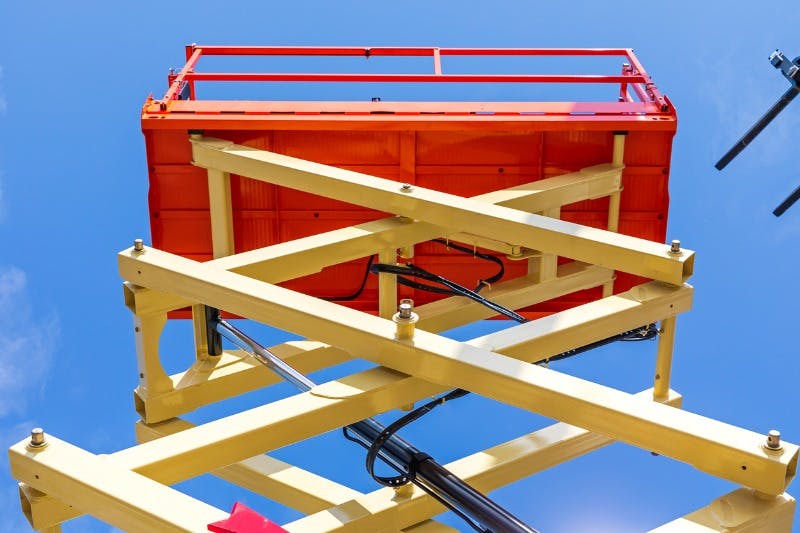Scissor lift is important as construction businesses have the most chances of injuries. In many times it is fatal. At the site, workers deal with any equipment. They should know how to operate it and how to protect them from risks. Construction work can be maintenance work or making a new structure with the help of machines. These machines can be lifters, bulldozers, graders, loaders, etc. Few times, workers have to go to 20 plus floors for doing construction work. For reaching different levels, laborers use, unlike means to get there. One of those helping platforms is scissor lifts.
WHAT ARE SCISSOR LIFTS?
Scissor lifts are the moving platforms. These platforms use to take workers and equipment from one place to other. Scissor lifts move in a vertical track. They are reliable for working inside and outside. They use in the maintenance or construction work, along with hanging holders. Scissors lifts reach the height of 20-50ft. It uses cross beams to lift the platform like a scissor. That is why it is called a scissor lift.
SCISSOR LIFT SAFETY AND OSHA
Scissor lifts consider as safest lifting platforms. But they have risks factor. That is why scissor lifts and their hazard protection are part of OSHA. According to OSHA, in different scissor lift accidents, ten people lost their lives. Their lives can be safe if workers follow prevention methods. OSHA does not have any standard regulations for scissor lifts. But scissor lifts indirectly come under 926.451 1926.453, with the regulation of scaffoldings.
SCISSOR LIFT SAFETY AND HAZARDS
Although scissor lifts are safe to use, they have the potential for damage. Most of the time, it was the mistake of a worker that caused harm. OSHA highlighted three problems that need to notice before operation. These are:
- Fall Protection
- Stabilization
- Positioning
These are also safety standards of scissor lifting. The employer must address all possible dangers at the site. Check the equipment before work. Allow only train staff to operate scissor lifts. Lifter drivers must know their duties. They know how to work with scissor lifters. And they should also identify that the lifter is maintained and equip for work. Scissor lifts workers should know the manufacturing details. And they wear PPE at the worksite.
FALL PROTECTION
While working on a height, the most dangerous thing is falling. Workers look for falls, need to use personal protective equipment. Also, use the harness and confirm that the platform of the scissor lift has a bars system. Only train workers use the platform, and they should check the bars. Before using scissor lifts, make sure the floor, guardrail, and mechanism are working correctly.
STABILIZATION
The essential thing to learn about scissor lifters is they can fall. Employers should examine the surface before using it. An unstable and rocky ground is not beneficial for lifter and workers' life.
The lifter should not allow working near pitfalls, slopes, and holes. For a steady lifter, need to use under 28mph wind speed. A stable working ground is a significant part of working with a scissor lifter.
POSITIONING
Lifter's position is foremost for saving the life of workers. The hazard of a moving lifter is that a worker can crush between two vehicles. Similarly, while working on the lifter, the worker can face electrocution. The worker does not need to be doing powerline work for that purpose. So, it is necessary to look at surroundings before working. A poor mistake can be hazardous.
PREVENTION STANDARDS
The main point of any workplace is the safe execution of work no, worker or equipment should hurt. Scissor lifters are secure but, they are machines, and a slight mistake can make a hazard. We already discussed above that how to use lifters safely. Now, few more things are necessary to address.
- The first thing is to check out the surroundings. Each place has a different ground setting, so it is beneficial to check it before an operation. Another thing to know at the site is other possible hazards. That might become a problem during work. The working conditions do not seem safe to use a scissor lifter plan before.
- The second thing is the protection which includes the machine and worker. Before using scissor lifters, look out for faults. It is essential to check the lifter priorly all the buttons and parts are in working order. Test the emergency buttons in heavy machines. They stop the lifter in an emergency. It also requires checking the brakes and guardrail system before use. And the use of PPE for workers' safety.
- The third thing is the training of workers. PPE is not enough to save workers, but they require training ahead of working at a site. In this training, they learn about the use and operation of lifters. How to stop hazards and what to do if an accident happens.
Scissor lifters or any equipment at the worksite should be deal with care. Ahead of using it, the company should have a clear policy and risks assessment conducted.



